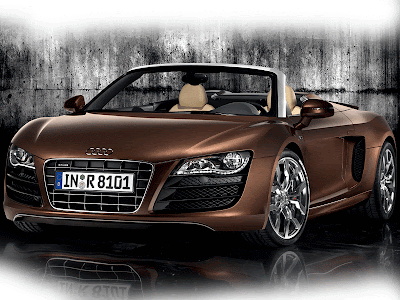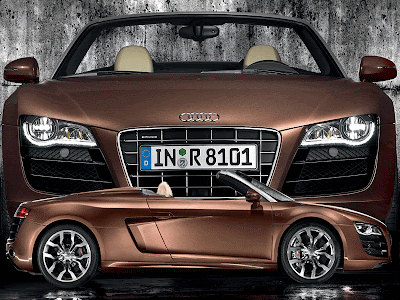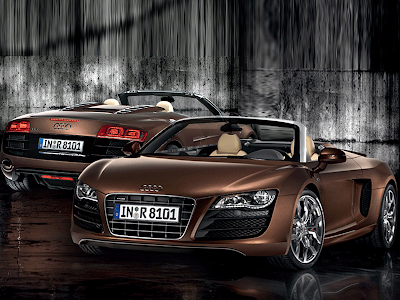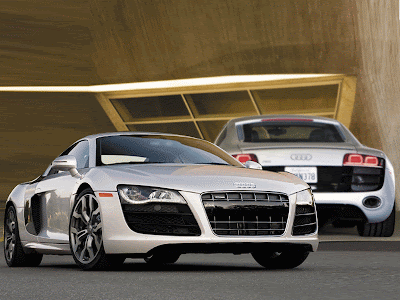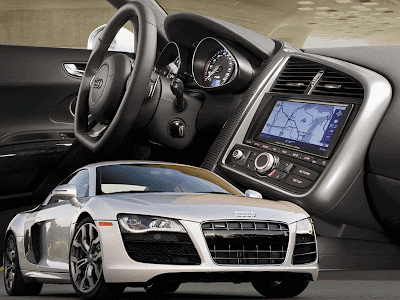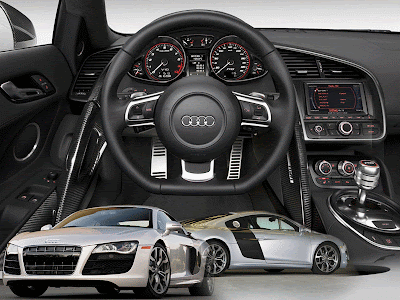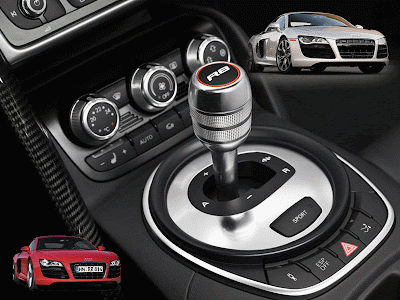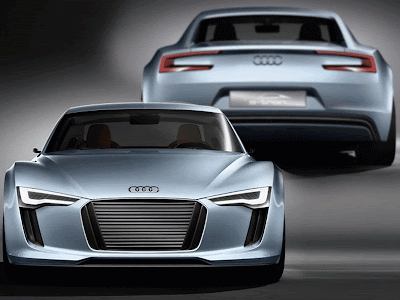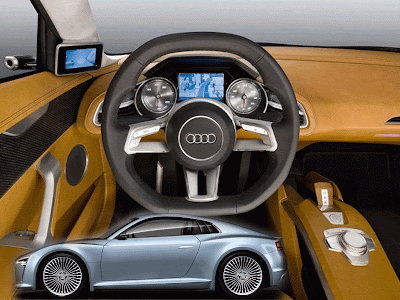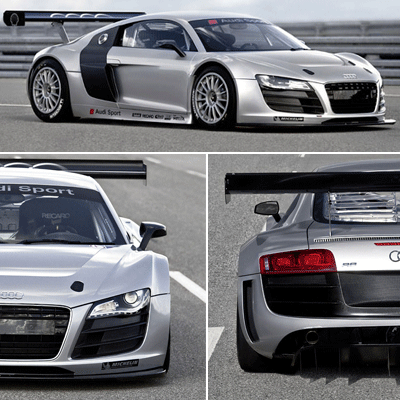Showing posts with label Audi. Show all posts
Showing posts with label Audi. Show all posts
2010 Audi R8 Spyder 5.2 FSI quattro V10 engine
While everybody and their brother likes the R8, there is a small, but vocal minority that's always thought coupe looked a little funny. Well, that group of naysayers can now put a sock in it, as the R8 Spyder is simply gorgeous. Gone are the carbon fiber side blades, in are sensible but somehow better looking slab sides. Regardless, it's simply hot. Exceptional performance and breathtaking dynamism coupled with the intense sensations of open-top driving: Audi presents the R8 Spyder 5.2 FSI quattro. Its lightweight cloth top opens and closes fully automatically; several body parts are made of a carbon fiber composite material.
2010 Audi R8 Spyder 5.2 FSI quattro V10 engine
The V10 engine produces 386 kW (525 hp) and launches the open-top two-seater to 100 km/h (62.14 mph) in 4.1 seconds; 0 – 200 km/h (124.27 mph) in 12.7 seconds; on its way to a top speed of 313 km/h (194.49 mph) with the six-speed manual transmission. The 5.2-liter engine features FSI direct fuel injection. Equipped with a manual transmission, the R8 Spyder 5.2 FSI quattro consumes an average of 14.9 liters of fuel per 100 km (15.79 US mpg) – a good figure given its power. With R tronic, this figure improves to 13.9 liters (16.92 US mpg). Featuring technologies such as the Audi Space Frame (ASF), quattro permanent all-wheel drive, full-LED headlights and with an innovative seatbelt microphone available as an option, the R8 Spyder 5.2 FSI quattro is the new top-of-the-range Audi.
2010 Audi R8 Spyder 5.2 FSI quattro V10 engine
Unlike the Coupé, the Spyder does not have sideblades behind the doors. The side panels and the large cover over the storage compartment for the cloth top are made of a carbon fiber composite. Two arched cowls, which extend to the spoiler lip and include large, integrated air vents, give the rear of the open-top two-seater a powerful profile.
2010 Audi R8 Spyder 5.2 FSI quattro V10 engine
The electrohydraulic soft top opens and closes in 19 seconds, even while driving at speeds up to 50 km/h (31.07 mph). When opened, it folds like a Z into its storage compartment over the V10 engine. The compartment cover opens and closes automatically. The heated glass window, which is separate from the cloth top, is lowered into the bulkhead. It can be independently raised and lowered at the press of a switch, with the top up or down. Audi offers the R8 Spyder 5.2 FSI quattro with a choice of three colors for the top. The body is available in eleven paint finishes, with metallic and pearl effect finishes standard. The windshield frame is coated with anodized aluminum. The leather for the seats are colored with pigments that reflect the infrared component of sunlight, which keeps the seats up to 20 degrees Celsius (68 degrees Fahrenheit) cooler.
2010 Audi R8 Spyder 5.2 FSI quattro V10 engine
A worldwide first is the optional seatbelt microphone for the hands-free unit, which makes it possible to talk on the phone even with the top down on the highway. Three small, flat microphones are integrated into both seatbelts. At least one of them is ideally positioned relative to the speaker when the belt is on. There is a fourth microphone in the windshield frame.
2010 Audi R8 Spyder 5.2 FSI quattro V10 engine
The quattro permanent all-wheel drive features a central viscous coupling and distributes power to all four wheels with a heavy rear bias. It works together with the locking differential on the rear axle to provide significantly greater traction, stability, cornering speed and precision. It is the superior technology – in particular for a high-performance sports car.
Labels: 2010, Audi, Coupe, Sports Car, V10
2010 Audi R8 V10 5.2 FSI quattro
Audi announced that the price for the highly anticipated 2010 Audi R8 5.2 FSI quattro V10 sports car will be rolled out in Germany in the second quarter of 2009 at a basic price of EUR 142,400. The Audi R8 V10 is the result of cumulative know-how from Audi's string of Le Mans victories. Its naturally aspirated engine combines racing technology such as dry sump lubrication with FSI gasoline direct injection. The ten-cylinder design is the perfect synthesis for impressive top performance, mighty pulling power, and low weight. Starting in 2009, this engine will also prove its potential on the world's racetracks - in the new Audi R8 GT3 racing car Audi is developing for customer teams in conformance with the GT3 rules.
2010 Audi R8 V10 5.2 FSI quattro
Audi R8 V10 5.2 FSI quattro is the next variant of its top-of-the-line model. With the Audi R8, the brand has established itself at the forefront of high-end sports cars from the very start - and now comes the Audi R8 V10. Its 5.2-liter, ten-cylinder engine churns out 386 kW (525 hp) and 530 Nm (390.91 lb-ft) of torque, which makes for breathtaking performance. With superior Audi technologies such as quattro all-wheel drive, the lightweight aluminum body, the innovative all-LED headlights, and its striking design, the Audi R8 V10 takes pole position against the competition.
2010 Audi R8 V10 5.2 FSI quattro
The V10 engine in the production sports car will be almost identical in construction to the one in the racing version. Its displacement is 5,204 cc, at 6,500 rpm it delivers 530 Nm (390.91 lb-ft) of torque, at 8,000 rpm its power tops out at 386 kW (525 hp). The specific power output is 100.9 hp per liter of displacement - and each hp has to propel only 3.09 kilograms (6.91 lb) of weight, because the Audi R8 V10 in the version with the six-speed manual gearshift weighs only 1,620 kilograms (3571 lb). The engine accounts for 258 of these kilograms (569 lb) - that's only 31 kilos (68 lb) more than the V8.
2010 Audi R8 V10 5.2 FSI quattro
The 5.2-liter powerplant uses direct injection according to the FSI principle developed by Audi. The Audi R8 V10 with R tronic gets by on an average of 13.7 liters per 100 km (17.17 US mpg). The Audi R8 V10 5.2 FSI quattro rockets from zero to 100 km/h (62.14 mph) in 3.9 seconds. In the version with the sequentially shifting R tronic it reaches 200 km/h (124.27 mph) in another 8.1 seconds. Even then its propulsive power hardly lessens: it's sufficient to reach a top speed of 316 km/h (196.35 mph). The immense force, the spontaneity and the thrust of the acceleration, plus the sound of the engine - all these impressions coalesce into a breathtaking sports car experience. The V10 plays a concert with growling bass tones and powerful high notes, which grows into a grandiose fortissimo as the engine revs up. This sonorous acceleration doesn't reach its limit until 8,700 rpm.
2010 Audi R8 V10 5.2 FSI quattro
A contributing factor to the wide lead in traction and driving safety of the Audi R8 V10 over the competition is quattro all-wheel drive - it's the superior technology especially for a high-performance sports car. Four powered wheels get more grip than two. They enable the driver to step on the gas sooner when coming out of a curve. It's not only the traction that benefits, but also the transverse dynamics and the stability.
2010 Audi R8 V10 5.2 FSI quattro
Labels: 2010, Audi, Sports Car, V10
2010 Audi e-tron Sports Car Concept
The Detroit Audi e-tron Concept is 3.93 meter (154.72 in) long and 1.78 meter (70.08 in) wide but just 1.22 meter (48.03 in) tall two-seater; just a few months after the debut of the Audi e-tron Concept at the 2009 Frankfurt Motor Show, this is now the second electric concept vehicle from the brand with the four rings. Audi is showing an uncompromising purist compact sports car with all-electric drive at the 2010 NAIAS. Lithium-ion batteries, located for an optimal center of gravity behind the passenger compartment and ahead of the rear axle, make an effective energy content of 45 kilowatt-hours available. This makes an operating range of up to 250 kilometers (155.34 miles) realistically possible.
2010 Audi e-tron Sports Car Concept
Coupled with the Detroit Audi e-tron Concept's low gross weight of around only 1,350 kilograms (2976.24 lb), high-torque power units driving the rear wheels guarantee commensurate road performance. Two electric motors with a combined output of 150 kW (204 hp) and 2,650 Nm (1954.54 lb-ft) accelerate the coupe with ASF-design aluminum body from 0 to 100 km/h (62.14 mph) in just 5.9 seconds. The Audi e-tron Concept accomplishes the sprint from 60 to 120 km/h (37.28 - 74.56 mph) in a mere 5.1 seconds.
As previously with the first Audi e-tron Concept car shown in Frankfurt, Audi again bases all components in this electric vehicle on an integral concept with many revolutionary details: a heat pump as an efficient means of heating up and maintaining the interior temperature. The drive system, power electronics and battery have innovative thermal management - crucial for maintaining a high operating range coupled with outstanding interior comfort.
2010 Audi e-tron Sports Car Concept
The two electric motors, which have their own cooling system, are mounted on the rear axle. This special package, featuring a 40:60 weight distribution, ensures perfect balance, which contributes to the driving dynamics of the Audi e-tron Concept.
The trapeze of the single-frame grille dominates the distinctly wedge-shaped front end and is flanked by two large air intakes. The top of the grille merges into the flat strips of the adaptive matrix beam headlight modules with their clear glass covers. All light units use ultra-efficient LED technology.
One design element that is specific to electric vehicles developed by Audi - such as the Audi e-tron - are the air intakes in the single-frame grille and behind the side windows on the C-post. They are closed flush under normal circumstances and opened by retracting slats when additional cooling air is required. The slats above the drive unit then also open to provide a better through-flow of air. These measures, too, maximize efficiency - the concept car is outstanding for an already low drag coefficient that is further improved when the flaps are closed.
2010 Audi e-tron Sports Car Concept
The combination of aluminum and carbon fiber-reinforced composite material guarantees supreme rigidity coupled with low weight. Audi will soon use this technology in a similar form for future production vehicles. Despite the complex drive system layout with two electric motors and a high-capacity battery system, the total weight of the Audi e-tron Concept on display in Detroit is only around 1,350 kilograms (2,976.24 lb).
The MMI is controlled via a scroll pad with a touch-sensitive surface on the steering wheel ("MMI touch") - an element inspired by modern smartphones. The steering wheel itself is clearly flattened off at both the top and bottom, in a clear reference to motor sport.
A smartphone that can be integrated into the front section of the center console interfaces between the vehicle, the driver and external information sources. The driver can use a suitably equipped conventional smartphone as a car phone, address database, navigation system and video player. At the same time they can also use it as an operating unit for many specific on-board systems in the Audi e-tron Concept. Many phones that are suitable for these functions are already available from various manufacturers.
2010 Audi e-tron Sports Car Concept
Characteristic for the concept of the Audi e-tron - and therefore also characteristic for a further development in an electric vehicle - is the near total elimination of switches and small components such as the ignition. The climate control unit is located to the right above the steering wheel. The display provides temperature and ventilation information. Again drawing inspiration from a smartphone, the system is controlled by means of a touch-sensitive sliding control.
Labels: 2010, Audi, Concept Car, Sports Car
Audi O Sports Car Concept
The Audi O concept was designed to fuse a powerful and innovative audio system with a stylish and sporty four-seat hatchback. The exterior design uses several Audi trademark styling themes, especially at the front where the square grille sits neatly between the LED headlights.

Audi O Sports Car Concept
The doors feature glass windows running along the bottom edge which provide an interesting shape to the profile of the car. At the rear of the car the pullout door echoes the design of the squared off Audi grille. The 2008 Audi O concept was designed by Ondrej Jirec, a design student from the Czech Republic who is beginning studies at the Art Center College of Design, Pasadena, California in 2008.
The interior of the Audi O concept is bright and airy thanks to a full length panoramic roof which floods the cabin with light. Inside, the passenger compartment has been separated from the engine compartment by a double firewall to help keep out external noise which might interfere with the powerful sound system.
The Audi O concept features a unique audio system which has internet connectivity for downloading music onto the built-in 650 GB hard drive. When parked up a Bluetooth system can connect two or more Audi O cars to play audio over a wider area. In this situation, a host Audi O is set to be the source of sound and the other vehicles act as speakers.
 Audi O Sports Car Concept
Audi O Sports Car Concept The Audi O also features a pullout rear door fitted with a DJ set with mixing decks. The decks can also be removed and used anywhere outside the car.
Powering the Audi O concept is fuel efficient diesel/electric hybrid drivetrain.
Labels: Audi, Concept Car, Sports Car
The Audi Avatar is a concept vehicle which was created by Edwin Conan (Yi Yuan), a graduate of RMIT (Royal Melbourne Institute of Technology) University in Australia. The Avatar was developed during Edwin's final year at the university as part of his degree project.
The Avatar is an electric powered supercar concept which is designed for about 20-25 years in the future. The shape was inspired by the 1937 Auto Union Type C Streamline racing car, and both cars - even though they are separated by a century - share the same clinical lines and pronounced wheel arches.
2009 Audi Avatar concept Car
There are no conventional doors to the Avatar, instead the vehicle utilizes a three-part canopy which opens upward to provide entry and exit. The main canopy opens forward together with the steering wheel and the dashboard, while two smaller canopies above the passenger seats open backwards. At the same time a panel in the bodywork drops down to act as a step.
2009 Audi Avatar concept Car
The interior of the Audi Avatar features a three-seat layout with the driver sitting in a central position forward of the passenger seats. The driver is met with a futuristic dashboard which consists of a transparent LCD display which provides all essential driving data. In the center of the steering wheel is another screen which provides navigation information. Additional information can also be projected onto the canopy to provide a heads-up-display similar to those found in high performance aircraft.
Thanks to a drive-by-wire system the Avatar's steering wheel can be swapped out quickly and easily in favor of a joystick or even a keypad depending on driver preferences.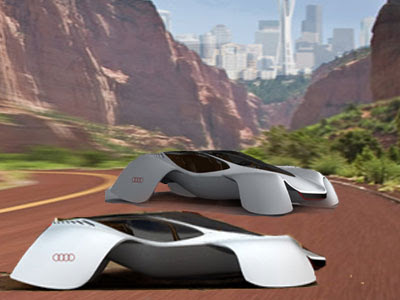
2009 Audi Avatar concept Car
2009 Audi Avatar concept Car
The wheels of the Avatar are housed inside the car's four 'legs'. The legs are constructed from a deformable material which allows it to change shape when the wheel is turned. To increase the vehicle's agility and handling, the Avatar features a four-wheel-steering system. The front wheels provide most of the steering, while the rear wheels can turn up to 10 degrees.
Labels: 2009, Audi, Concept Car, Design Car, Electric Car, Super Cars
The 2009 Audi S4 is powered by a 3.0 litre V6 with direct fuel injection and what Audi call "mechanical turbocharging" (supercharging), delivers 245 kW (333 hp) yet consumes only 9.7 liters of fuel per 100 km (24.25 US mpg). quattro permanent four-wheel drive, sports suspension and a high-performance brake system control the power reliably. With optional performance technologies - the seven-speed S tronic, the new sport differential and the Audi drive select dynamic driving system - both new S models from Audi are extending their lead even further.
It takes just two figures to comprehend the dynamic potential of the new Audi S4 and S4 Avant: 5.1 seconds for the sprint from zero to 100 km/h (62.14 mph) and only 4.4 seconds for the intermediate sprint from 80 to 120 km/h (49.71 - 74.56 mph) in fourth gear. Behind these figures there is a fascinating driving experience, marked by the sonorous sound of the new mechanically supercharged V6 engine, its mighty propulsive power, its free-revving character and its sharp, spontaneous response to the throttle.

2009 Audi S4 Seven-Speed S-tronic
The 3.0 TFSI is the new range-topping unit in Audi's V6 engine family. It Develope 333 horsepower and 324 lb-ft (440 Nm) of torque at 2,500 rpm, the engine is connected to either a standard six-speed manual gearbox, or an optional seven-speed, dual-clutch transmission which can be used either as a conventional automatic or as a sequential semi-auto with steering wheel mounted paddles.
Now the supercharger is staging a comeback - the T in the engine description no longer stands for the turbocharger alone. Extensive comparative tests revealed the mechanical supercharger to be superior to a biturbo concept for the big V6 engine. In conjunction with direct injection this concept has clear advantages in terms of the prioritized features of packaging, starting performance and responsiveness.
The supercharger is so compact that is easily accommodated in the 90-degree V of the cylinder banks, in place of the intake manifold. The engine-driven Poly-V belt that powers the mechanical turbocharger provides full thrust right from idling speed. The 3.0 TFSI delivers its maximum 440 Nm (324.53 lb-ft) at only 2,900 rpm and maintains this constantly until 5,300 rpm. The intermediate sprint from 80 to 120 km/h (49.71 to 74.56 mph) is completed in fourth gear in 4.4 seconds; even in sixth gear it takes a mere 7.1 seconds.

2009 Audi S4 Seven-Speed S-tronic
The seven-speed S-tronic gearbox of the 2009 S4 consists of two separate transmissions and uses two multidisk clutches that control the various gears. The large K1 clutch guides the power via a solid shaft to the pinions for gears 1, 3, 5 and 7. A hollow shaft rotates around the solid shaft; it is connected to the compact K2 clutch, which is integrated within its larger counterpart and controls the pinions for gears 2, 4, 6 and reverse gear.
Both transmission structures are continuously active, but only one is powered at a time by the engine. The quattro all-wheel-drive system sends power to all four wheels. A 40/60 percent front/rear torque bias ensures that the handling remains sporty yet stable. However, when necessary, the power distribution can be varied within fractions of a second.
The gas paths after the supercharger are very short which is why the 3.0 TFSI builds up torque extremely quickly when accelerating, even more dynamically than a naturally aspirated engine of the same displacement. The 3.0 TFSI responds directly to the throttle in true sporty fashion, is agile and sprightly, revving up to the maximum of 7,000 rpm with playful ease.

2009 Audi S4 Seven-Speed S-tronic
The 2009 Audi S4 shares the same styling cues as the rest of the model lineup. Some of the most striking modifications to the exterior design are the special aprons, the aluminum-look exterior mirrors, the 18-inch S-design light-alloy wheels, the side rocker panels, the discreet rear spoiler and the quadruple exhaust system. The xenon plus headlights with daytime running lights and the rear lights are further distinctive touches.
New Sports Audi R15 Tdi Petit Le Mans Race
Britain’s Allan McNish (pictured) came tantalisingly close to achieving his fifth Petit Le Mans race victory at Road Atlanta on Saturday (26 Sep) and maintaining Audi’s 100% winning record in the annual American sportscar endurance race since the German manufacturer’s debut in 2000.
The Dumfries-born double Le Mans 24 Hour race winner and Italian co-driver Dindo Capello led for the opening 4hrs before the Scotsman suffered two spins and dropped to third place on the treacherously wet and slippery track in Georgia - moments before the race went in to a Safety Car period and was ultimately stopped with almost five hours run.
After a further delay of almost four hours and near constant heavy rain, organisers decided not to re-start the event which in any case was limited to 10 hours or 1,000-miles, leaving the McNish/Capello diesel-engined Audi R15 TDI classified third, a mere 3.465secs behind the winning Peugeot (Franck Montagny/Stephane Sarrazin).
The McNish/Capello Audi had started from third place on the 27-car grid but McNish swept in to the lead on the opening lap. The “sister” R15 TDI of Lucas Luhr/Marco Werner began from fourth place, a position the German duo were classified in, one lap down on the top-three, when the race was declared over. Meanwhile the McNish/Capello Audi won the efficiency award “Michelin GreenX Challenge” – a trophy awarded to the most environmentally friendly car.
Audi unexpectedly contested a third race of the year to collect further race information about its new sports-prototype in preparation for the Le Mans 24 Hours next June.
The Dumfries-born double Le Mans 24 Hour race winner and Italian co-driver Dindo Capello led for the opening 4hrs before the Scotsman suffered two spins and dropped to third place on the treacherously wet and slippery track in Georgia - moments before the race went in to a Safety Car period and was ultimately stopped with almost five hours run.
After a further delay of almost four hours and near constant heavy rain, organisers decided not to re-start the event which in any case was limited to 10 hours or 1,000-miles, leaving the McNish/Capello diesel-engined Audi R15 TDI classified third, a mere 3.465secs behind the winning Peugeot (Franck Montagny/Stephane Sarrazin).
The McNish/Capello Audi had started from third place on the 27-car grid but McNish swept in to the lead on the opening lap. The “sister” R15 TDI of Lucas Luhr/Marco Werner began from fourth place, a position the German duo were classified in, one lap down on the top-three, when the race was declared over. Meanwhile the McNish/Capello Audi won the efficiency award “Michelin GreenX Challenge” – a trophy awarded to the most environmentally friendly car.
Audi unexpectedly contested a third race of the year to collect further race information about its new sports-prototype in preparation for the Le Mans 24 Hours next June.
Labels: Audi, Diesel Car, Diesel Engine Car, Engine Car, Prototype, Sports Car
Audi Sport will offer a racing sports car specifically developed for customer use in the form of the powerful 500 hp plus GT3 version of the Audi R8 which will be available from autumn 2009. The logistics and factory space required for the AUDI AG customer programme will be created over the next few months in Ingolstadt, Neckarsulm and Györ.
The Audi R8 conforms to the production-based GT3 regulations allowing the car to be fielded in numerous national and international race series.
Because the GT3 regulations prohibit the use of four-wheel drive the Audi R8 comes with the typical GT rear-wheel drive. The power is transmitted via a newly developed six-speed sequential sports gearbox. The suspension uses almost exclusively components from the production line. A comprehensive list of safety equipment guarantees the highest-level of passive safety. A modified front end and a large rear-wing generate the required downforce for the race track.
The Audi R8, which bears the project name “R16” within Audi Sport, was developed under the direction of Audi Sport. Mid August, the first prototype successfully completed a roll-out in the hands of Audi factory driver Frank Biela.
The Audi R8 conforms to the production-based GT3 regulations allowing the car to be fielded in numerous national and international race series.
Because the GT3 regulations prohibit the use of four-wheel drive the Audi R8 comes with the typical GT rear-wheel drive. The power is transmitted via a newly developed six-speed sequential sports gearbox. The suspension uses almost exclusively components from the production line. A comprehensive list of safety equipment guarantees the highest-level of passive safety. A modified front end and a large rear-wing generate the required downforce for the race track.
The Audi R8, which bears the project name “R16” within Audi Sport, was developed under the direction of Audi Sport. Mid August, the first prototype successfully completed a roll-out in the hands of Audi factory driver Frank Biela.
Subscribe to:
Posts (Atom)
